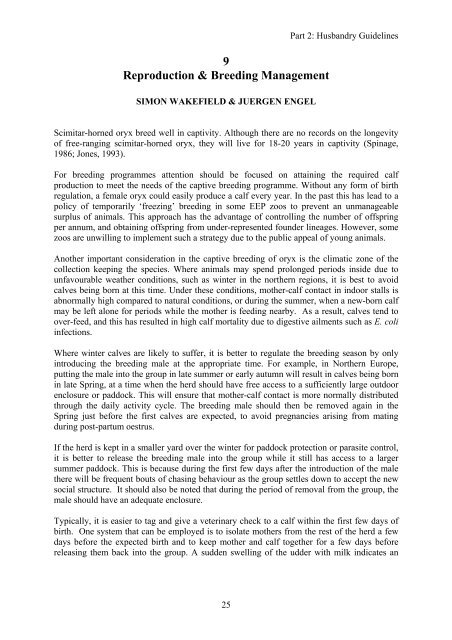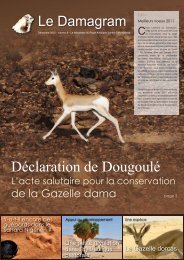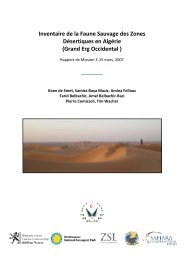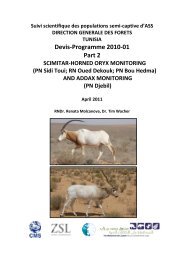The Biology, Husbandry and Conservation Scimitar-horned Oryx ...
The Biology, Husbandry and Conservation Scimitar-horned Oryx ...
The Biology, Husbandry and Conservation Scimitar-horned Oryx ...
You also want an ePaper? Increase the reach of your titles
YUMPU automatically turns print PDFs into web optimized ePapers that Google loves.
9<br />
Reproduction & Breeding Management<br />
SIMON WAKEFIELD & JUERGEN ENGEL<br />
25<br />
Part 2: <strong>Husb<strong>and</strong>ry</strong> Guidelines<br />
<strong>Scimitar</strong>-<strong>horned</strong> oryx breed well in captivity. Although there are no records on the longevity<br />
of free-ranging scimitar-<strong>horned</strong> oryx, they will live for 18-20 years in captivity (Spinage,<br />
1986; Jones, 1993).<br />
For breeding programmes attention should be focused on attaining the required calf<br />
production to meet the needs of the captive breeding programme. Without any form of birth<br />
regulation, a female oryx could easily produce a calf every year. In the past this has lead to a<br />
policy of temporarily ‘freezing’ breeding in some EEP zoos to prevent an unmanageable<br />
surplus of animals. This approach has the advantage of controlling the number of offspring<br />
per annum, <strong>and</strong> obtaining offspring from under-represented founder lineages. However, some<br />
zoos are unwilling to implement such a strategy due to the public appeal of young animals.<br />
Another important consideration in the captive breeding of oryx is the climatic zone of the<br />
collection keeping the species. Where animals may spend prolonged periods inside due to<br />
unfavourable weather conditions, such as winter in the northern regions, it is best to avoid<br />
calves being born at this time. Under these conditions, mother-calf contact in indoor stalls is<br />
abnormally high compared to natural conditions, or during the summer, when a new-born calf<br />
may be left alone for periods while the mother is feeding nearby. As a result, calves tend to<br />
over-feed, <strong>and</strong> this has resulted in high calf mortality due to digestive ailments such as E. coli<br />
infections.<br />
Where winter calves are likely to suffer, it is better to regulate the breeding season by only<br />
introducing the breeding male at the appropriate time. For example, in Northern Europe,<br />
putting the male into the group in late summer or early autumn will result in calves being born<br />
in late Spring, at a time when the herd should have free access to a sufficiently large outdoor<br />
enclosure or paddock. This will ensure that mother-calf contact is more normally distributed<br />
through the daily activity cycle. <strong>The</strong> breeding male should then be removed again in the<br />
Spring just before the first calves are expected, to avoid pregnancies arising from mating<br />
during post-partum oestrus.<br />
If the herd is kept in a smaller yard over the winter for paddock protection or parasite control,<br />
it is better to release the breeding male into the group while it still has access to a larger<br />
summer paddock. This is because during the first few days after the introduction of the male<br />
there will be frequent bouts of chasing behaviour as the group settles down to accept the new<br />
social structure. It should also be noted that during the period of removal from the group, the<br />
male should have an adequate enclosure.<br />
Typically, it is easier to tag <strong>and</strong> give a veterinary check to a calf within the first few days of<br />
birth. One system that can be employed is to isolate mothers from the rest of the herd a few<br />
days before the expected birth <strong>and</strong> to keep mother <strong>and</strong> calf together for a few days before<br />
releasing them back into the group. A sudden swelling of the udder with milk indicates an





